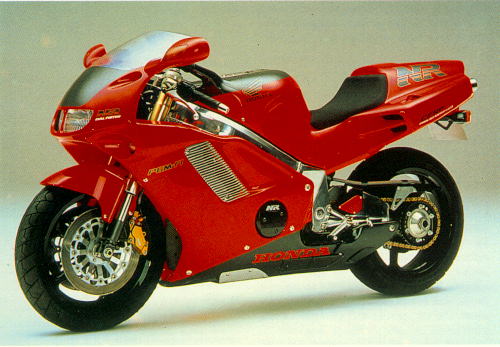Honda NR750

The NR750 was Honda's opportunity to show what they can do, but its beautiful engineering was lost on the public. The engine technology, the complex exhaust routing, and touches like carbon fibre composite bodywork and a titanium-tinted screen were not what most observers thought of as the way forward. It was quite heavy, and definitely not intended as a race machine. And of course the ludicrous price (£38,000 in the UK, ¥5,000,000 in Japan) was enough to ensure it remained a curiousity.
Some features, such as the side-mounted radiators and aspects of the styling eventually into Honda's more modest road models, but the enormous expense of developing an oval-pistoned v-four motorcycle means such a design is unlikely to be sold at realistic prices. The conventional v-four engine is already complex and expensive to produce.
The PGM-FI fuel injection was state of the art in 1992, and used 7 sensors and a 16-bit CPU to control the eight injectors as well as controlling ignition timing. In addition it altered the position of an inlect duct in the airbox to regulate airflow. Over 200 were assembled, at a rate of 2 or 3 a day.
Since it couldn't be homologated for World Championship racing Honda decided the NR750 could be used to attempt some records. A lightened, tuned NR, making 150bhp @ 15,500rpm and weighinhg just 180kg was produced (compared to the standard bikes' 222kg). Diminutive GP rider Loris Capirossi set new flying mile, flying kilometre and standing start mile & 10km records, assuring its place in the record books.
Honda had tried the oval-piston concept before. The first motorcycle named NR750 was an endurance racer which appeared at Le Mans in 1987. It failed to finish, but was very fast with a wide powerband. It weighed just 145kg and made over 150bhp - in the days when superbikes were doing well to put out 135 horses. The fascinating development of Honda's v-fours in both race and road guises, including the oval-piston NR bikes, is discussed in detail in Julian Ryder's book "Honda's V-Force". Read the review.
There were only eight NR750s imported into the UK. Performance Bikes managed to scrounge a ride on the only bike that hadn't been crashed and repaired (there were two) or exported (the other five).
The engine ticks over with the same V-four rumble as an RC45, but open the NR up... different story. Four oval pistons deliver what the rider and then the throttle demands: a noise seeps from deep inside the bike like someone cutting a bass drum in half with a chainsaw.The only criticism was of the brakes, which required more effort than one would like. However,
Forget noise, riding it is even better. For starters, you'd swear you were sitting on a fat RVF400 - the NR is only 7mm taller. Riding position is racy without being cramped or uncomfortable. High pegs and low seat mean knees often bump elbows, but the reach to the bars holds a body in a near perfect riding position - you don't hold onto the NR, it holds you to leave the upper body totally free of tension. You can get this dream-like feeling, and can move to any position on the bike with no effort. It's sublime.
this is the only imperfection the NR suffers from and it's only worth mentioning cos there's nothing else to fault.Fast Bikes magazine found no such problems with the brakes at the Paul Ricard circuit launch. Read extracts from the article, originally printed in the January 1992 issue.
| NR750 | |
|
Engine type:
Capacity Bore & Stroke Cylinder Size Compression Ratio Power Torque Front wheel Rear wheel Wheelbase Rake / trail Fuel capacity Dry weight |
90° V4 DOHC 32 valve
747.7cc 75.3 x 42mm 101.2 x 50.6mm 11.7:1 125PS @ 14,000 rpm 7kg/m (50.5 ft/lbs) @ 11,5000 rpm 130/70 ZR16 180/55 ZR17 1433mm 24° 30' / 87mm 17.3 litres 222.5kg |
RC41 - the French specification NR750
The NR750 model imported into France was different enough from the rest that it was given a different vehicle description code (RC41). In order to achieve the 100bhp output legal limit the RC41 features different profile camshafts and reprogrammed PGM-FI units. Models destined for the Swiss and Austrian markets featured additional emissions control equipment, notably an air injection system. Finally, the MPH/KPH switch was only on UK-spec models.
Relevant links